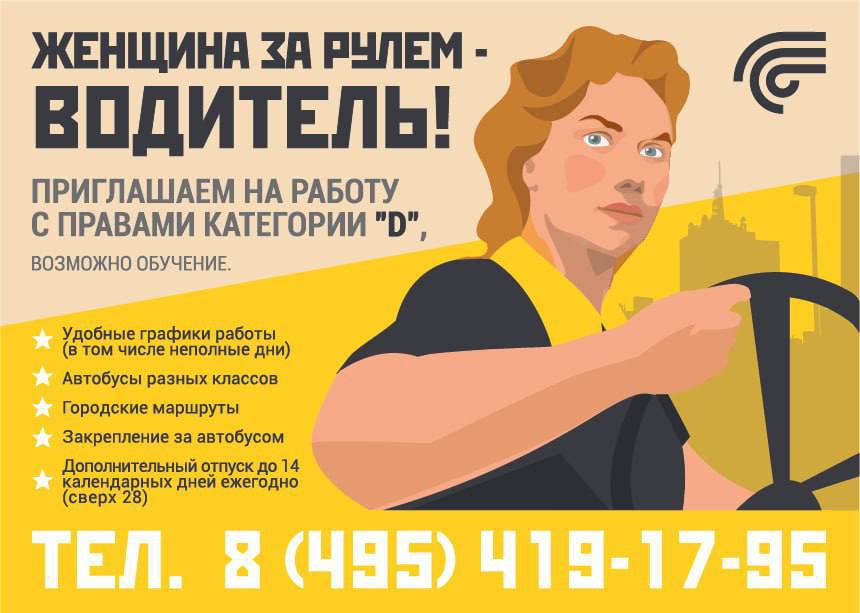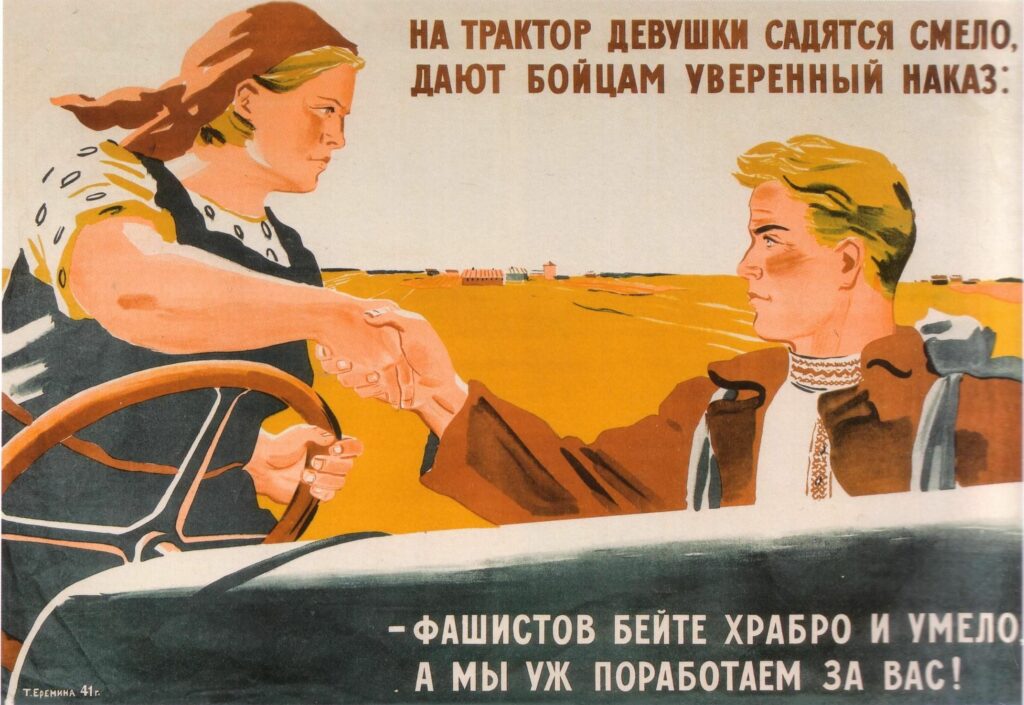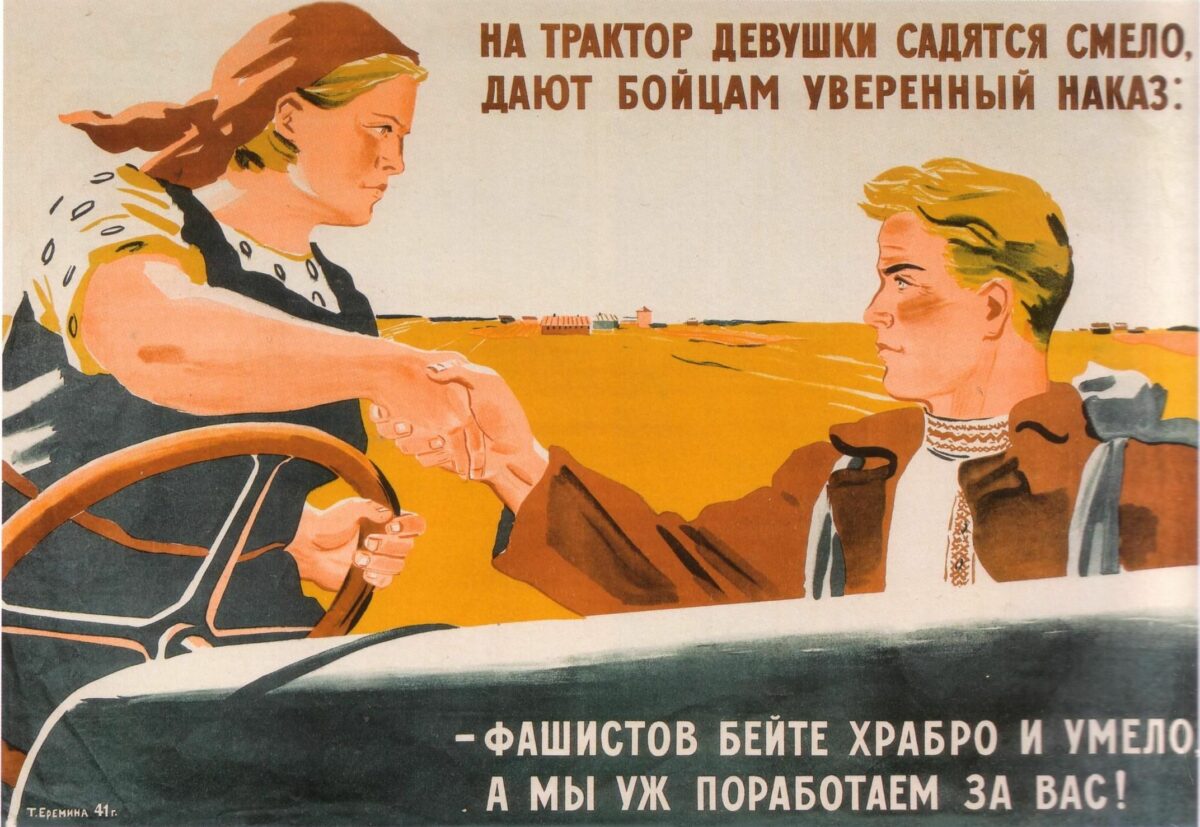Translation of a column published in DOXA in Russian.

«The woman behind the wheel is the driver,» says the propaganda of the Moscow region transport.
From the poster, a stern, old-fashioned cold wave-laden woman behind the wheel looks into the distance. The nostalgic font, heavily associated with the USSR, Rodchenko’s iconography, the tone of voice — everything refers us to the imaginary USSR. In the slush of 2023, the heroine of the poster «Girls Sit Boldly on the Tractor» from 1941 turned to the Russians. Only the man who is sent to beat the fascists had to be removed from the poster — after all, comradely shaking hands with him would be too radical for the Putin regime, which suffers from the phantom pains of «traditional values.»

This campaign, as well as the return of the Order of the Mother Heroine, illustrates well the attempts of the Russian government to mobilize Russian women on all fronts using the methods of the Great Patriotic War. But at the same time, the emancipatory foundation of the socialist project of gender equality is washed out of modern Russian propaganda — only an attempt to exploit women’s paid and unpaid labor and a militaristic overtone remain.
Soviet women and World War II
Dear Joseph Vissarionovich!
Oktyabrskaya Maria Vasilyevna.
In the battles for the Motherland, my husband, the Regimental Commissar Oktyabrsky Ilya Fedotovich, was killed. For his death, for the death of all Soviet people tortured by fascist barbarians, I want revenge on these fascist dogs, a cause for which I contributed all my personal savings into the State Bank as a means to build a tank – 50,000 rubles. I request that the tank be named ‘Combat Girlfriend’, and that I be allowed to operate it during frontline operations. I can already drive and operate a machine-gun, and I have been trained as a ‘Voroshilov’ sharp-shooter. I send you my warmest greetings and wish you long, long years of life. May you strike fear into our enemies and for the eternal glory of our Socialist Motherland.
In many European countries, the Second World War was a serious blow to the pre-war gender contract: women had to be included in new areas and professions, replacing men who had gone to the front. For the USSR, the contrast was not at all so striking, because many women already worked in industry, and were included in politics and local government. Moreover, as researcher Anna Krylova writes, although gender was conceptualized in the binary categories of male and female, they were not opposed to each other, and contained many internal conflicts and contradictions about what it meant to be a woman and what it meant to be a man. Even the mass mobilization of women did not cause a radical break in the already highly disoriented gender contract of the Stalinist USSR.
«The Stalinist totalitarian regime in the 1930s, despite its characteristic punitive treatment of its citizens, enabled more varied popular ways of viewing and expressing gender than the more liberal Soviet postwar and post-Stalinist era. In fact, I argue that prewar official culture, institutional terrains, and gender policies promoted and operated with varied, ambiguous, and, often, blatantly contradictory notions of gender.<…> What connected the key media of Stalinist cultural production such as press, literature, and film as well as the terrain of Soviet education and paramilitary training was a perpetual state of controversy over the meaning of such staple notions of Stalinist ideology as women’s equality, gender relations, and bourgeois prejudice.
The parameters of this controversy introduce us to a society that was acutely gender-aware, a society that routinely addressed itself, both publicly and in its professional pedagogical journals, employing the category of gender and debating its meanings.» (Krylova 2010, 20)
The changes brought about by the war in the position of women — mobilizations, women’s battalions, the development of new military professions, and their even greater inclusion in paid work — only added more turbulence to the controversial Soviet gender policy. This was also reflected at the level of legislation, for example, in the decree of 1944 «On increasing state assistance to pregnant women, large families, and single mothers.» This decree, on the one hand, significantly improved the rights of working women: increased maternity leave, prohibited the involvement of pregnant women in overtime work, those with babies in night shifts, and so on. On the other hand, the same law introduced the «single mother» category, making it impossible to put the father’s name on the child’s birth certificate if the parents’ marriage was not registered — this was a huge step backward from previous Soviet legislation, according to which children born out of wedlock had the same rights as children in a formal marriage. Contradictions were often the result of the participation in lawmaking of conflicting groups and interests, and, to a large extent, women themselves.
The war generation in the Soviet gender policy
Military experience and the great merit of Soviet women in the victory over Nazi Germany played an important role in their self-determination and political participation. As historian Mie Nakachi writes, the experience of independent action during the war years made it possible for many professional groups, including doctors, to feel empathy, which gave them the opportunity to participate actively in post-war politics. Nakachi, for example, attributes the decriminalization of abortion in the USSR in 1955 to precisely this sense of self among female doctors (Nakachi 2021, 6). In that particular story, a key role was played by Maria Dmitrievna Kovrigina, at that time the Minister of Health of the USSR. The way Kovrigina described the contrast of Soviet women with French women in the memoirs of her first trip to Europe in 1945 captures this connection between the victory in the war and the special historical mission of Soviet women:
I am convinced that it was very interesting to watch us from afar. There is a group of women, almost all of them tall (and of considerable weight), dressed in solid heavy coats, some in gray, well-fitted commander’s coats. The steps are large; the steps are solid. You can’t confuse us with French women, most of them are running in light coats [palʹtishki] and jackets [kurtochki], mincing their feet [nozhki], tangled in short and tight skirts [iubochki].
<…> Our large and multinational delegation was greeted with loud shouts and thunderous applause. It must be said that the Soviet delegation was at the center of attention all the days of the congress. We were not only carefully examined from head to toe but even touched [bold added — A.T.]. Everyone wanted to touch the women of a distant, unfamiliar, and mysterious country [bold added — A.T.], whose people made a decisive contribution to the victory over German fascism.
Kovrigina 1985, 103-105
The «otherness» Kovrigina felt could develop into many different affects: humiliation, discrimination, exclusivity, pride, and so on. In the case of Kovrigina (and not only) her «otherness» compared to Western women was articulated as a unique and heroic position in international politics dedicated to the protection of women’s rights and the struggle for peace. This special position was literally rooted in their bodies, which had survived radical upward social mobility (from peasant background to the Soviet representative in the international arena) and the war.
This connection between the victory over Nazism and the special role of Soviet women was reinforced by the fact that March 8 became a day off in the USSR in 1965 «in commemoration of the outstanding merits of Soviet women in communist construction, in defending the Motherland during the Great Patriotic War, their heroism and dedication at the front and in the rear, as well as noting the great contribution of women to strengthening friendship between peoples and the struggle for peace». The revolution and emancipation receded into the background, but the defense of the Motherland, the front and rear, and the struggle for peace appeared. Together with the first military parade on Red Square since 1945 and the mass installation of war memorials, March 8, International Women’s Day, became a public holiday. Women’s rights turned out to be an organic part of the patriotic position, but they also turned out to be closely intertwined with militarism.
The equality of Soviet women became a symbol of the progressiveness of socialism in the international ideological battle against capitalism — and this context set the aggressively militant tone of this struggle during the Cold War with repeated references to the feat of Soviet women in the Second World War. This cocktail of patriotism, militarism, women’s rights and socialism poses a serious challenge to current Russian feminist struggles.
Nevertheless, the militancy of the war generation of women in Soviet politics brought us a lot: we are indebted to them for the right to abortion, protective labor legislation, and the development of a network of preschool institutions. Speculating, one might say that to some extent, these Soviet women rethought their contribution to the defense of the Motherland as protecting women from exploitation by the state and their partners. But this is my interpretation and inspiration. At the level of official discourse, women were required to be unquestioningly patriotic — and this is what made their work invisible.
The involvement of women in political and public work was discussed from the very beginning of the Soviet state, in the Khrushchev years it became loud again — in the late 1950s, women’s councils appeared, which, in fact, consolidated the participation of women in advocating their interests (albeit only in some spheres of life) as part of women’s citizenship. A woman is not only a mother and worker but also an activist. This made it impossible to talk about the feminist movement in the USSR as autonomous from state-approved public work. Despite the fact that this work brought many results in the field of our rights, many scholars think that feminism in the USSR did not exist.
«Traditional Values« and «Defense of the Motherland»
Being a Soviet woman meant being someone who knew that she had rights and fought for them (often against other groups in state/party/trade union management). And if we understand «traditional values» as those practiced by previous generations, then in the case of Russian feminists, this is what they are, gender equality (albeit not achieved) as the pride of the country and the struggle for women’s rights as part of women’s social citizenship.
But this is where the «defense of the Motherland» comes into play, this militaristic echo of women’s rights is turned upside down by contemporary Russian government and is actively used to legitimize the current war. It removes contradiction between women’s rights and militarism and allows for actions like «Make-up for camouflage» or attempts to mobilize women to support the war.
It is our feminist task in the present to rehabilitate the real Soviet «traditional values» following the history of the women’s movement, in the sense of egalitarian political-economic principles at the level of laws, urban infrastructure and discourses. After all, as history shows, authoritarian regimes are just dung for our growing emancipation. On the other hand, it is important for us to rethink the usual categories, including «defense of the Motherland,» clearing them of militarism. It is worth defending the Motherland first of all from poverty, violence, war, corrupt politicians and unscrupulous capital.

Sasha Talaver, a Ph.D. Candidate in Gender Studies (CEU, Vienna), a left and feminist activist from Russia.

